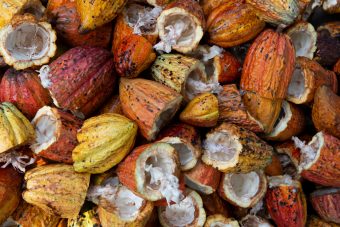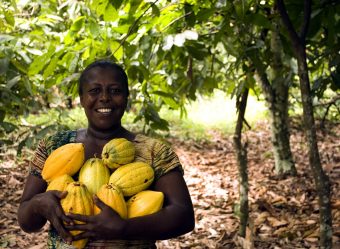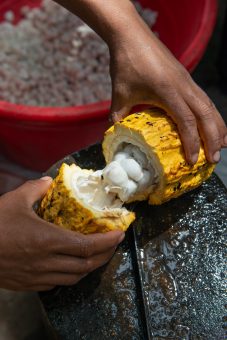
Sougue Kadjatou is a 45-year-old farmer who lives with her husband and two children in Agboville, a village in Côte d’Ivoire. Her cocoa plantation, where she works every day from morning until early afternoon, is a 40-minute walk from the village. “I’m glad they told me to plant banana and timber trees in my cocoa plantation,” she says. “It’s good to plant various trees. The bananas give me something to eat and sell, whereas the timber is a friend of the cocoa—it gives it shade. Later on, I’ll be able to sell the timber for home building and furniture which will hopefully give me enough money to build my own house for my family.”
Kadjatou is not the only one practising agroforestry. “Before I used to plant cocoa without planting other trees,” says Guitty Saidou, a farmer from the same village. “Worse, I would take a piece of forest and clear all the trees away and then plant my cocoa. But for the past five years, I’ve been introducing banana, timber, orange and avocado trees and now things are much better for me. With the other trees around it, the cocoa gives a good harvest because the trees are healthier.”
A vicious cycle
Côte d’Ivoire has the fastest rate of deforestation in Africa—and one of the fastest in the world. According to the Food and Agriculture Organization of the United Nations, the Ivorian forest cover is down to 8 per cent.
The consequences have been dramatic: a major drop in rainfall and other devastating alterations in local climatic conditions that threaten the culture of cocoa, Côte d’Ivoire’s main agricultural commodity.

Cocoa has brought prosperity to the country. However, decades of production have exhausted the soil. The decreasing fertility of unsustainably-operated plantations has led local farmers to encroach on forests in search of more productive land. As a result, the cocoa sector, a casualty of the climate crisis, is also the main driver of deforestation in Côte d’Ivoire.
Agroforestry, or zero-deforestation agriculture
The issue is so serious that Côte d’Ivoire signed the UN New York Declaration on Forests in 2014 and committed to restoring the national forest to 20 per cent of the territory by 2030. Within this context, one of the most promising solutions is planting associated trees in cocoa plantations.
“Agroforestry, though not the only solution to deforestation, is potentially one the most effective,” says Jonathan Gheyssens, REDD+ and Sustainable Land Use Programme Officer at the UN Environment Finance Initiative. “It means the diversification of revenue streams and reducing monoculture risks for smallholder farmers who face fluctuating cocoa export prices. It also increases their resilience to climate variations and makes a positive contribution to climate change mitigation.”

The UN-REDD Programme, a joint global initiative of the Food and Agriculture Organization of the United Nations, the United Nations Development Programme and the UN Environment Programme, works with cooperatives such as the one in Agboville where both Kadjatou and Saidou are members.
The cooperative helps the farmers switch to agroforestry through training. “The shadow of the trees protects the roots of the cocoa plant,” says trainer Amory Parfait, explaining the importance of planting other trees besides cocoa. “We started this diversification two years ago, and we now plant avocado, orange and mango trees amongst the cocoa.”
In addition to promoting agroforestry, the UN-REDD Programme also advocates for increased agricultural productivity with improved plant material while making use of good practices.
“A lot of forests were destroyed to make way for plantations,” says Jean Paul Aka, national sustainable land use finance specialist and REDD+ expert. “Half of it went to cocoa production, the rest to palm oil and rubber.”
Old cocoa seeds used to require a lot of land because the yield was low. New cocoa varieties can yield up to four times as much product, but only with the right knowledge. They do not resist the harsh sun, for example, but they do produce very fast—after 18 months instead of four years—and three times more than the older generation of cocoa trees.
“For the new seed to work, a lot of shadow, fertilizer and protection against diseases is needed and the farmers need advice on good agricultural practices,” says Aka. “If you use the new seeds, you have better production and you can harvest all year long, provided there’s enough rain.”
Source: UNEP

